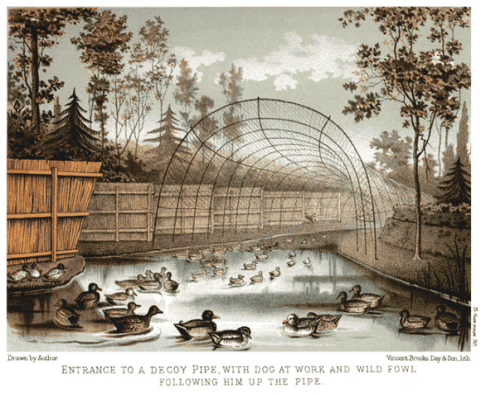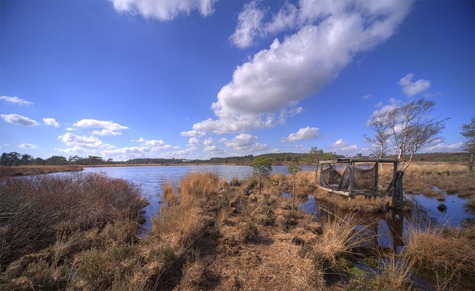Family history information can be found in the oddest places. The strangest source I've used is The Book of Duck Decoys: Their Construction, Management and History, written by Sir Ralph William Frankland-Payne-Gallwey (you couldn't make that name up) and published in 18861.
According to Sir Ralph:
A Decoy is a cunning and clever combination of water, nets, and screens, by means of which wildfowl, such as Wigeon, Mallard, and Teal, are caught alive. A Decoyman is the man who works and manages the Decoy, and who by his art, as well as by his knowledge of the birds and their surroundings when in the waters of the Decoy, entraps them.
In 1831, my 3x great grandfather, James Munden (1790-1855), was employed as a decoyman on the Charborough Park estate at Morden, Dorset, owned by the Drax family. Sir Ralph's book contains a map of the decoy where James worked:
He also provides some useful information about the demise of the decoy:
Morden, 6 miles N. of Wareham, on the property of Miss Drax of Charborough Park. There used to be a Decoy here until 1856, when it ceased to be worked, and since then the shooting around it having been let, the place has been too much disturbed to admit of the Decoy being successfully carried on.
Today the old decoy pond is part of the Morden Bog National Nature Reserve. The curved arms of the pond can still clearly be seen in this beautiful photograph:
This is a landscape immortalised by Thomas Hardy as Egdon Heath in novels such as The Return of the Native and The Mayor of Casterbridge. It must have looked much the same in James Munden's time as it does today, though the wild people of Hardy's novels have been replaced by the wild creatures living on this Site of Special Scientific Interest:
Near the pond there is a Grade II listed building, called the Decoy House. It is described in the listing as:
Detached cottage. Late C18-early C19. Brick walls, thatched roof with brick parapets to west gable, brick stacks. One storey and attics. Ground floor has central casement window with glazing bars - replacing original door, and 2 C20 metal windows. Attic has 2 dormers with casements with glazing bars. Cl9 single-storey wing on west, of brick with slate roof. 2 ledged doors, 2 casement windows with glazing bars and one C20 metal window. Internally, main ground floor room has large open fireplace with timber lintel. Possibly the Decoy Keeper's cottage.
If this was the decoyman's cottage, then James, his wife Elizabeth (nee Snelling) and nine children would have been living there in 1831.
And the freakish footnote? If I shared the genealogy world's obsession with "correct" citation, it might look something like this:
1. Frankland-Payne-Gallwey, Sir Ralph William, "The Book of Duck Decoys: Their Construction, Management and History," Decoymans.co.uk (Online: John Norris, 1999) [originally published as The Book of Duck Decoys: Their Construction, Management and History, London: J Van Voorst, 1886], page 73, <http://www.decoymans.co.uk/>, accessed 19 January 2011.
But I don't - and that's a subject for another post.




This is really thinking outside the box! I'm curious to know how you *found* the Book of Duck Decoys?!
ReplyDeleteJudy, I wasn't really sure what a decoyman did so I Googled the word and it turned up the online copy of the Book of Duck Decoys. It was pure serendipity that the book had information about the specific decoy where my ancestor was employed.
ReplyDeleteNice! Serendipity certainly plays an important role in family history. If memory serves me correctly, there are some great examples in blog posts by Shauna HICKS.
ReplyDeleteAnyone know why some locals refer to decoy house as the haunted house? Also any annecdotes on the story of villans who took a safe to this location to blow it open?
ReplyDelete